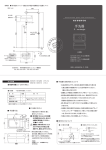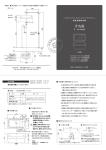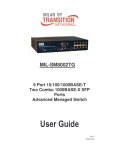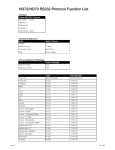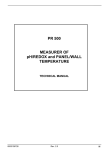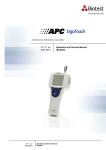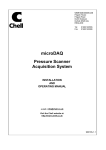Download OSA4531 rev-i5
Transcript
OSA 4531-E1 GPS-SB GPS - Synchronization Box USER MANUAL Model 945.453.1S0.x00 OSA 4531-E1 - User Manual - Revision I - August 2009 This page has been intentionally left blank OSA 4531-E1 - User Manual - Revision I - August 2009 ii What's new in this revision SUB-D connector description - distinguish male or female OSA 4531-E1 - User Manual - Revision I - August 2009 iii This page has been intentionally left blank OSA 4531-E1 - User Manual - Revision I - August 2009 iv Contents Table of Contents 1. 2. 3. 4. INTRODUCTION .................................................................................................................1-1 1.1 About this Manual ..................................................................................................1-3 1.1.1 Copyright Notice .........................................................................................1-3 1.2 Reading Guide ........................................................................................................1-4 1.3 Safety Instructions .................................................................................................1-5 1.4 Warranty..................................................................................................................1-8 1.5 Certification ............................................................................................................1-9 GENERAL DESCRIPTION ................................................................................................2-11 2.1 Overview ...............................................................................................................2-13 2.2 Functions ..............................................................................................................2-13 EQUIPMENT DESCRIPTION ..............................................................................................3-1 3.1 Block Diagram ........................................................................................................3-3 3.2 Input Selection........................................................................................................3-3 3.3 Holdover Capability................................................................................................3-4 3.4 Phase Build-Out......................................................................................................3-5 3.5 Output Squelching .................................................................................................3-6 3.6 Front Panel Layout .................................................................................................3-6 3.6.1 Connectors .................................................................................................3-6 3.6.2 Operational State........................................................................................3-7 INSTALLATION ..................................................................................................................4-1 4.1 Unpacking and Inspection .....................................................................................4-3 4.2 Working Conditions ...............................................................................................4-4 4.3 Tools required ........................................................................................................4-4 4.4 Wall Mounting Option.............................................................................................4-5 4.5 Rack Mounting Option ...........................................................................................4-6 4.5.1 19" Mounting...............................................................................................4-6 4.5.2 ETSI Mounting ............................................................................................4-6 4.6 Power Supplies.......................................................................................................4-7 4.6.1 Power-Up....................................................................................................4-7 4.7 GPS Antenna and Auxiliary Input Connections ...................................................4-9 4.7.1 Auxiliary Input Connection ..........................................................................4-9 4.8 Output Connection ...............................................................................................4-10 4.9 Alarm Output Connection ....................................................................................4-11 4.10 Start-Up .................................................................................................................4-12 4.10.1 Operation Modes ......................................................................................4-12 OSA 4531-E1 - User Manual - Revision I - August 2009 v Contents 4.10.2 5. 6. 7. 8. Power-Up..................................................................................................4-14 CONFIGURING THE UNIT ..................................................................................................5-1 5.1 Overview .................................................................................................................5-3 5.2 User Settings ..........................................................................................................5-3 5.2.1 Auxiliary Input .............................................................................................5-3 5.2.2 Loop Time Constant....................................................................................5-3 5.2.3 Time Zone ..................................................................................................5-3 5.2.4 Cable Delay ................................................................................................5-3 5.2.5 User Offset .................................................................................................5-4 5.2.6 Administrative State....................................................................................5-4 5.2.7 Priorities......................................................................................................5-4 5.2.8 Wait-To-Restore Time.................................................................................5-4 5.2.9 Conditional Squelch....................................................................................5-4 5.2.10 Working Mode.............................................................................................5-5 5.2.11 Alarm Mask.................................................................................................5-5 5.2.12 Output Type................................................................................................5-5 5.2.13 Baud Rate...................................................................................................5-5 5.2.14 Time-Of-Day Function.................................................................................5-5 5.3 Default Factory Settings ........................................................................................5-6 5.3.1 Generic Settings .........................................................................................5-6 5.3.2 Setting for Article A014494 / 945.453.1S0.060............................................5-6 LOCAL MANAGEMENT......................................................................................................6-1 6.1 Overview .................................................................................................................6-3 6.2 RS-232 Port Connection.........................................................................................6-3 6.3 RS-232 Port Configuration .....................................................................................6-4 6.4 Command List ........................................................................................................6-5 6.5 Command Descriptions .........................................................................................6-8 SPECIFICATIONS...............................................................................................................7-1 7.1 Input Specifications ...............................................................................................7-3 7.2 Tracking Subsystem Characteristics ....................................................................7-4 7.3 Output Specifications ............................................................................................7-5 7.4 Remote Functions ..................................................................................................7-5 7.5 General Specifications ...........................................................................................7-6 MAINTENANCE ..................................................................................................................8-1 8.1 Overview .................................................................................................................8-3 8.2 Oscilloquartz Contact Information ........................................................................8-3 8.2.1 Technical Assistance ..................................................................................8-3 8.2.2 Sales ..........................................................................................................8-4 APPENDIX A : ORDERING INFORMATION.............................................................................. A-1 OSA 4531-E1 - User Manual - Revision I - August 2009 vi Contents GLOSSARY...................................................................................................................................... I DOCUMENT HISTORY .................................................................................................................. III OSA 4531-E1 - User Manual - Revision I - August 2009 vii List of Figures List of Figures Figure 3-1 Block Diagram ............................................................................................................3-3 Figure 3-2 Example of Filtering the GPS Synchronization Signal .................................................3-4 Figure 3-3 Schematic Presentation of the Phase Build-Out..........................................................3-5 Figure 3-4 Front Panel - 9-18V Version........................................................................................3-6 Figure 3-5 Front Panel - 18-60V Version......................................................................................3-6 Figure 4-1 Wall Mounting Option..................................................................................................4-5 Figure 4-2 Rack Mounting Option ................................................................................................4-6 Figure 4-3 Power Supply Connection...........................................................................................4-8 Figure 4-4 Input Connections.......................................................................................................4-9 Figure 4-5 TEX-P Connection to OSA 4531-E1 .........................................................................4-10 Figure 4-6 Output Connection....................................................................................................4-10 Figure 4-7 Alarm Output Connection..........................................................................................4-11 Figure 4-8 State Diagram...........................................................................................................4-13 Figure 6-1 RS-232 Connection.....................................................................................................6-3 OSA 4531-E1 - User Manual - Revision I - August 2009 viii List of Tables List of Tables Table 3-1 Connector Description..................................................................................................3-6 Table 3-2 Operational State .........................................................................................................3-7 Table 5-1 Generic Factory Settings..............................................................................................5-6 Table 5-2 Factory Settings for Article A014494 ............................................................................5-6 Table 6-1 Command List..............................................................................................................6-7 Table 7-1 Input Specifications......................................................................................................7-3 Table 7-2 Tracking SubSystem Characteristics............................................................................7-4 Table 7-3 Output Specifications ...................................................................................................7-5 Table 7-4 Remote Functions Specifications .................................................................................7-5 Table 7-5 General Specifications .................................................................................................7-6 Table 8-1 Ordering Units............................................................................................................. A-1 Table 8-2 Ordering Miscellaneous Accessories........................................................................... A-1 OSA 4531-E1 - User Manual - Revision I - August 2009 ix List of Procedures List of Procedures Procedure 4-1 Power-Up .............................................................................................................4-7 OSA 4531-E1 - User Manual - Revision I - August 2009 x Introduction Chapter 1. Introduction Including : About this Manual Reading Guide Safety Warranty Certification OSA 4531-E1 - User Manual - Revision I - August 2009 1-1 Introduction This page has been intentionally left blank OSA 4531-E1 - User Manual - Revision I - August 2009 1-2 Introduction 1.1 About this Manual This manual has been designed to provide basic and detailed information for the correct use and operation of the OSA 4531-E1. It summarizes the overall equipment concept and theory of operation, describes the hardware itself and provides information related to installation, operation and maintenance. It is intended for the use of the following types of users: 1.1.1 Systems Engineers: An overview of the equipment concept and theory of operation. Installation Engineers: Detailed technical information and procedures for correct installation, operation, configuration and commissioning as well as equipment specifications and maintenance guidelines. Maintenance Engineers: Information on troubleshooting, maintenance and equipment technical data. Copyright Notice Copyright © 2009 Oscilloquartz SA All Rights Reserved The Oscilloquartz product described in this book is furnished under a license agreement and may be used only in accordance with the terms of the agreement. The contents and information in this document are provided in connection with Oscilloquartz products. No license, expressed or implied by estoppels or otherwise, to any intellectual property rights is granted by this document. Except as provided in Oscilloquartz SA’s Terms and Conditions of Sale for such products. This document is exclusive property of Oscilloquartz SA and may not, in whole or in part, be copied, photocopied, reproduced, modified, translated, reduced to any electronic medium or machine-readable, stored in a retrieval system, or transmitted in any form without prior consent in writing from Oscilloquartz SA, Brévards 16, 2002 Neuchâtel 2, Switzerland. Every effort has been made to ensure the accuracy of this guide. However, Oscilloquartz SA makes no warranties with respect to this documentation and disclaims any implied warranties of merchantability and fitness for a particular purpose. Oscilloquartz SA shall not be liable for any errors or for incidental or consequential damages in connection with the furnishing, performance, or use of this manual or the examples herein. Oscilloquartz SA may make changes to specifications and product descriptions at any time, without notice. OSA 4531-E1 - User Manual - Revision I - August 2009 1-3 Introduction 1.2 Reading Guide Special icons, attracting your attention, precede important and/or critical information in this document. Hereafter are explanations of each icon. CAUTION This symbol is extremely important and must not be neglected. It precedes information or procedures regarding installation, operation or maintenance. Follow all steps or procedures, as instructed, to avoid any damage to equipment or serious personal injury. ELECTRICAL SHOCK HARZARD This warning symbol is extremely important and must not be neglected. It indicates that there are dangerous high voltages present inside the enclosure of this product and precedes important warnings to avoid any risk of fire or electrical shock that could lead to serious personal injury or loss of life. ESD CAUTION Electrostatic Discharge (ESD) must be avoided so as not to damage or destroy static sensitive components. Note: A note symbol informs the reader that additional information on the related subject is provided in order to simplify a described task, suggest other references or even just simplify an explanation. Recommendation: Recommendations advise the user on manufacturer tested methods and procedures proven valuable for correct use and optimum equipment results. OSA 4531-E1 - User Manual - Revision I - August 2009 1-4 Introduction 1.3 Safety Instructions IMPORTANT SAFETY INSTRUCTIONS. DO NOT DISCARD, READ BEFORE OPERATING GENERAL Exercise extreme care when handling any electronics equipment as it contains precision parts that can be damaged by improper handling. Avoid touching connector pin surfaces. Foreign matter deposited on contact surfaces can cause corrosion, and eventually lead to degradation of performance. In addition, do not use abrasives to clean contact/pin surfaces. ESD CONSIDERATION Each module contains semiconductor devices that can be damaged by electrostatic discharges. It is advisable to take anti-static precautions when handling electronic boards or static sensitive components. Use an approved anti-static bracelet in accordance with company practice. WATER AND MOISTURE Do not place containers with liquids such as coffee, water, sodas, etc. on this unit. Do not operate this equipment in a wet environment. HEATING Do not install this product near heat sources such as radiators, air ducts, areas subject to direct, intense sunlight, or other products that produce heat. OSA 4531-E1 - User Manual - Revision I - August 2009 1-5 Introduction VENTILATION Slots and openings in the unit are provided for ventilation and to ensure reliable operation of the product. To protect the unit from overheating, those openings must not be blocked or covered. GROUNDING EARTH CONNECTION IS ESSENTIAL BEFORE CONNECTING TO THE SUPPLY. The OSA 4531-E1 must be connected to Earth Ground (common bounding network (DC-C)). The wire used for the connection must be a minimum of AWG16. Ensure that all other devices connected to the 4531-E1, are connected to protective (earth ground). (Grounding one conductor of a two-conductor outlet is not sufficient.) Any interruption of the protective (grounding) conductor (inside the equipment) or disconnecting the protective earth terminal is likely to make this equipment dangerous. Intentional interruption is prohibited. POWER Make sure the power sources are compatible with the power inputs of the equipment. The equipment's protective earth terminals must be connected to the protective conductor of the (mains) power cord or the station earth. The mains plug shall only be inserted in a socket outlet provided with a protective earth contact. The protective action must not be negated by the use of an extension cord (power cable) without a protective conductor (grounding). OSA 4531-E1 - User Manual - Revision I - August 2009 1-6 Introduction POWER CORD PROTECTION The power supply cord for this product should be routed or installed in such a manner to protect it from being walked on or pinched. The unit should be powered down completely before connecting or disconnecting the power cable. The power cord should be removed before moving the unit. The power cord must be placed near an easily accessible unobstructed socket outlet. CLEANING Connected and running equipment can only be dusted using a soft dry cloth. ONLY WITH, AUTHORIZED PERMISSION, OUT OF SERVICE & UNPLUGGED equipment can be cleaned with a soft cloth slightly moistened with a mild detergent solution. Do not use liquid cleaners, aerosols, abrasive pads, scouring powders or solvents, such as benzine or alcohol. Ensure the surface cleaned is fully dry before reconnecting power. SERVICING AND MODIFICATIONS To avoid dangerous electric shock, do not perform any servicing or modifications other than what is recommended in this User Manual. Do not attempt to gain access to areas of the unit where dangerous voltages are present. Refer servicing to qualified service personnel. DAMAGE REQUIRING SERVICE • Refer servicing to qualified service personnel under the following conditions: • When the power supply cord is damaged. • If liquid has been spilled into the enclosure of the unit. • If the product does not function normally by following the instructions in the User’s Manual. Adjust only those controls that are covered by the operating instructions. Improper adjustment of other controls may result in damage and will often require rework by a qualified technician to restore the product to its normal operation. • If the product has been damaged in any way. When the unit displays a negative, distinct change in performance. OSA 4531-E1 - User Manual - Revision I - August 2009 1-7 Introduction 1.4 Warranty This Oscilloquartz product carries a warranty which commences from date of dispatch from factory. Unless agreed otherwise or stipulated differently on the original acknowledgement of order, the duration of the warranty is twenty four months. It applies to demonstrably faulty material or poor workmanship, but excludes batteries. Oscilloquartz shall bear only the cost of repair or replacement in its own premises. Should this not be possible for reasons beyond our control, all additional costs are at customer expense. Repairs under warranty carry either the balance of the original warranty or a six months warranty, whichever is longer. Damages resulting from natural wear, improper maintenance, failure to observe the operating instructions, excessive strain, unsuited consumption material as well as improper environmental and mounting conditions are excluded from this warranty. The warranty expires if the customer or a third party modifies or repairs the product without Oscilloquartz's prior written consent or if the customer does not take immediate steps to prevent the damage from becoming more serious; likewise, if insufficient time is provided for repair or replacement. The customer will not be entitled to other warranty claims. Oscilloquartz is not liable for consequential damage. OSA 4531-E1 - User Manual - Revision I - August 2009 1-8 Introduction 1.5 Certification EQUIPMENT CERTIFICATION: Oscilloquartz equipment is tested according to well-defined procedures. Appropriate testing and inspection takes place at the component, board, equipment and system levels. The company maintains in-house cesium standards that are continuously compared to UTC. Before any equipment is released, it must satisfy the relevant tests and inspection schedules. The equipment is then issued with a "Certificate of Conformity" that guarantees its conformance with the relevant performance criteria. The OSA 4531-E1 GPS is designed to be compliant to: • EMC : EN50081-1, EN50082-1, EN61000-6-2 • SAFETY : EN60950 A variety of Oscilloquartz products are certified world-wide. For details, please refer to our web site at www.oscilloquartz.com COMPANY CERTIFICATION: • Certified since 1998 by the Swiss Accreditation Service and Swiss Federal Office of Metrology as an accredited laboratory for time and frequency. • Certified ISO 9001 since 1994 and ISO 14001 since 2000 by The Swiss Association for Quality and Management Systems (SQS) OSA 4531-E1 - User Manual - Revision I - August 2009 1-9 Introduction This page has been intentionally left blank OSA 4531-E1 - User Manual - Revision I - August 2009 1-10 General Description Chapter 2. General Description Including : Overview Functions OSA 4531-E1 - User Manual - Revision I - August 2009 2-11 General Description This page has been intentionally left blank OSA 4531-E1 - User Manual - Revision I - August 2009 2-12 General Description 2.1 Overview The OSA 4531-E1 GPS-SB is a GPS receiver which provides an accurate frequency derived from the Coarse Acquisition Link 1 signals transmitted by the Navstar Global Positioning System (GPS) satellites. In addition, the GPS 4531-E1 module is equipped with an auxiliary input, which accepts either frequency or E1 code. Depending of the configuration of the module, the GPS or the auxiliary input can be used as the reference for the tracking function. When locked, the 'GPS 4531-E1' regenerates the selected reference and attenuates jitter and wander on this reference. The time constant of the loop is programmable in the range of 100 to 50'000 seconds (2'000s default). When no valid input reference is available, the 'GPS 4531-E1' enters hold-over mode and holds its output frequency to the one that was available just before the loss of the input. 2.2 Functions The OSA 4531-E1 GPS-SB (GPS-Synchronization Box) is an Oscilloquartz GPS receiver with holdover capability together with G.703 auxiliary input. When locked to GPS, the OSA 4531-E1 GPS-SB fulfils the ITU-T rec. G.811. The OSA 4531-E1 GPS-SB performs the following: • Supplies ITU-T G.811 references with valid GPS signal, • Accepts one back-up synchronization reference input, • Monitors the status of the reference input signals (GPS and auxiliary synchronization signal), • Selects the highest priority (operator specified) synchronization input, • Selects the next available synchronization input in the priority table, if the current synchronization input has failed, • Automatic switching without phase jump, • Attenuates jitter and wander on the selected synchronization input, • Operates as a standby reference clock in hold-over mode if all synchronization inputs have decreased in quality or failed, • Communicates by a serial port (RS-232) with IBM-compatible PC for alarm reporting and equipment control. In addition, the OSA 4531-E1 GPS-SB also features: • Totally maintenance-free design. The OSA4531-E1 is manageable locally via Local Manager software and remotely via the renowned Oscilloquartz' SyncView™ synchronization network management system. This allows to combine, in the same network, the OSA with other Oscilloquartz synchronization OSA 4531-E1 - User Manual - Revision I - August 2009 2-13 General Description This page has been intentionally left blank OSA 4531-E1 - User Manual - Revision I - August 2009 2-14 Equipment Description Chapter 3. Equipment Description Including : Block Diagram Input Selection Holdover Capability Phase Build-Out Output Squelching Front Panel Layout OSA 4531-E1 - User Manual - Revision I - August 2009 3-1 Equipment Description This page has been intentionally left blank OSA 4531-E1 - User Manual - Revision I - August 2009 3-2 Equipment Description 3.1 Block Diagram 4531 GPS-SB Block Diagram Internal communication E1 or Frequency GPS engine Tracking System Micro Controller RS232C Auxiliary input OCXO 8663 Frequency & Time Code Output E1 or 2.048MHz 1PPS 10MHz Figure 3-1 Block Diagram 3.2 Input Selection The user has the possibility to configure the input selection process of the OSA 4531-E1 GPS-SB by choosing from a table listing the priority of each input. For example : Selecting the GPS signal to have higher priority than the auxiliary synchronization input. Input selection is reversible. 1 1 Reversible: If a valid input with higher priority than the current reference returns, the equipment will select the higher priority input as its primary reference input. OSA 4531-E1 - User Manual - Revision I - August 2009 3-3 Equipment Description 3.3 Holdover Capability The GPS 4531-E1 includes a holdover function provided by an OSA 8663 OCXO oscillator. 150 ns 50 ns -50 ns -150 ns GPS signal w/SA Output signal from '4531' 100'000 s Figure 3-2 Example of Filtering the GPS Synchronization Signal When the input module is locked to a GPS signal, the internal oscillator and memory function ensure that the reference synchronization signal fulfils ITU-T recommendation G.811, as shown in above Figure 2. By using the oscillator OSA 8663 OCXO, the OSA 4531-E1 GPS-SB maintains a sufficient synchronization signal, compliant to ITU-T rec. G.811, for some hours without visual GPS signal. 2 Please note that the U.S. DoD (Department of Defence) decided to disconnect the SA st (Selective Availability) after May 1 , 2000. In order to ensure that potential adversaries do not use GPS, the U.S. military is dedicated to the development and deployment of regional denial capabilities in lieu of global degradation. OSA 4531-E1 - User Manual - Revision I - August 2009 3-4 Equipment Description 3.4 Phase Build-Out When the equipment changes reference, it will go into holdover for a short period of time (approx. 2s) in order to provide a constant synchronization signal to the output units. Even though the two synchronization sources (GPS and Auxiliary) have the same frequency, they can still vary in phase. The result would be that the synchronization output would be affected by jump in phase, as shown in the figure (dotted line). In the OSA 4531-E1 GPS-SB, Oscilloquartz has eliminated this phase jump by adjusting the phase of the “new” reference signal during an extended holdover period (additional 20s). During this period, the element calculates a phase build-out constant that is used to align the phase of the reference with the phase of the internal holdover oscillator. Hence the elements avoid getting a phase jump on the outputs when switching from the internal holdover, to the reference signal. Phase Buildout Phase [φ] Sync Input 2 Phase buildout [Δφ] Sync Input 1 20s Output w/o phase buildout Output w/ phase buildout Time [s] 2s Provided by internal oscillator Figure 3-3 Schematic Presentation of the Phase Build-Out. OSA 4531-E1 - User Manual - Revision I - August 2009 3-5 Equipment Description 3.5 Output Squelching The OSA 4531-E1 GPS-SB supports conditional squelching where the operator can set the condition under which the outputs are squelched after a configurable delay after entering holdover mode. 3.6 Front Panel Layout 3.6.1 Connectors Figure 3-4 Front Panel - 9-18V Version LED LED Figure 3-5 Front Panel - 18-60V Version Connector Name Type Description ANT. IN BNC jack GPS Antenna Input AUX. IN BNC jack Auxiliary Reference Input E1/2.048MHz BNC jack 10MHz BNC jack 10MHz Sine Wave Output Signal, 1VRMS @ 50Ω 1PPS BNC jack 1PPS Output Signal, 2.4VPP @ 50Ω (ACMOS) 18-60V or 9-18V Weidmüller 5.08 / 2 poles Supply Voltage Input (floating) RS-232 SUB-D 9p, male RS-232 Communication Port ALARM Weidmüller 5.08 / 3 poles Electrical Alarm Output 2.048Mbps Output Signal, G703 / 75Ω 2.048MHz Output Signal, G703 / 75Ω Signal Ground Table 3-1 Connector Description OSA 4531-E1 - User Manual - Revision I - August 2009 3-6 Equipment Description 3.6.2 Operational State Alarm Conditions Power Supply ON Initialisation Warm-Up TrackedFast OCXO GPS AUX_IN 0 Antenna 0 Holdover 0 Bicolor LED Green ALARM ON ON x 0 1 Red OFF ON 0 1 x Red (blinking) OFF ON 1 0 0 Green (blinking) OFF ON 1 1 0 Red/Green (blinking) OFF OFF / Failure x x x Blank OFF 0 : no alarm condition or masked alarm condition 1 : active alarm condition ALARM Output : ON FAULT OFF FAULT Table 3-2 Operational State OSA 4531-E1 - User Manual - Revision I - August 2009 3-7 Equipment Description This page has been intentionally left blank OSA 4531-E1 - User Manual - Revision I - August 2009 3-8 Installation Chapter 4. Installation Including : Unpacking and Inspection Working Conditions Tools required Wall Mounting Option Rack Mounting Option Power Supplies GPS Antenna and Auxiliary Input Connections Output Connection Alarm Output Connection Start-Up OSA 4531-E1 - User Manual - Revision I - August 2009 4-1 Installation This page has been intentionally left blank OSA 4531-E1 - User Manual - Revision I - August 2009 4-2 Installation This section provides unpacking and Inspection instructions, working conditions, tools required and power up for the OSA 4531-E1. To prevent injury and/or equipped damage, do not ignore the warnings, notes and recommendations and read the section Safety Considerations Note: If you encounter problems during any of the following procedures, please contact Customer Services. 4.1 Unpacking and Inspection ESD CAUTION Electrostatic Discharge (ESD) must be avoided so as not to damage or destroy static sensitive components in the OSA 4531-E1. Please observe proper ESD handling procedures. Check first that the packing does not have any signs of rough handling such as dents or scratches, which might have occurred during transportation. Also inspect the equipment carefully for possible damages (knobs broken, handles bent, etc.). Should the equipment have suffered any damage, immediately notify the carrier and retain the packing material for inspection. CAUTION This instrument must be operated only as specified by the manufacturer. Use other than as specified may compromise the safety precautions of the system. OSA 4531-E1 - User Manual - Revision I - August 2009 4-3 Installation 4.2 Working Conditions In order to work within specification, the OSA 4531-E1 GPS-SB should be installed at a location which does not exceed the following working conditions: Operating temperature range : Humidity : 4.3 -5°C to +55°C Up to 95% non condensing Tools required For the installation and commissioning of the OSA 4531-E1 the following tools are needed: An IBM-compatible PC meeting the following requirements : a) b) c) d) e) f) g) Monitor Pentium Processor or better At least 16M of RAM Windows 98 or later CD-ROM drive RS-232 serial port Mouse • An RS-232 cable to connect the PC to the OSA 4531-E1 GPS-SB. • Configuration and Monitoring Software for the OSA 453x GPS Receiver Family (or Terminal Software) • Multimeter (DC and AC, frequency range up to at least 3 MHz) • Oscilloscope (bandwidth of at least 30 MHz) OSA 4531-E1 - User Manual - Revision I - August 2009 4-4 Installation 4.4 Wall Mounting Option For this purpose, the bottom of the shell provides six screw holes (M3) as below. (20) 37.88 126.5 74.63 M3 (6X) Maximal length of the mounting screws : 5.3mm (9.25) 39.25 43.25 (9.25) Figure 4-1 Wall Mounting Option OSA 4531-E1 - User Manual - Revision I - August 2009 4-5 Installation 4.5 4.5.1 Rack Mounting Option 19" Mounting The GPS-SB can be mounted in a 19" rack. The complete mounting kit can be ordered separately. 453X 6.6 x 10 (0.26 x 0.4) 76.2 (3) 88.1 (3.47) 482.6 (19") 465.1 (18.31) A A Screw M3x6 (0.11x0.23) 246 (9.68) 122 (4.80) 4x Max. 20 (0.78) GPS-SB 453X - 19" RACK MOUNT All dimensions in mm (inch) Figure 4-2 Rack Mounting Option 4.5.2 ETSI Mounting ETSI rack mounting is also possible. In this case, a 19" mounting kit (including mounting tray) and an additional ETSI kit (including ears to mount on the 19" tray) must be ordered. OSA 4531-E1 - User Manual - Revision I - August 2009 4-6 Installation 4.6 Power Supplies The OSA 4531-E1 GPS-SB is available in either of these power supply versions: Part Number Voltage Range 945.453.1S0.100 9 - 18 VDC 945.453.1S0.000 18 - 60 VDC CAUTION Check that the type of supply voltage corresponds to your power feed. 4.6.1 Power-Up In order to ensure correct powering-up of the system, it is necessary to follow these instructions: Procedure 4-1 Power-Up STEP ACTION 1 Connect the ground cable to the Signal Ground Stud if you wish to link the signal ground of the OSA 4531-E1 GPS-SB to earth. The ground stud is an M3 screw. Connection must be made with a suitable connector. 2 Measure voltage and polarity of the external power source before connecting it to the power input of the OSA 4531-E1 GPS-SB. The voltage must be within the specified range. 3 Allow for the GPS-SB to warm up, so that the internal oscillator can reach its operating temperature. The minimum warm-up time is 10 minutes (24 hours before full specification are obtained). During this time no outputs are available(*). (*) Depends firmware version. 4 Power Consumption : 8 W typical @ +25°C (steady state). OSA 4531-E1 - User Manual - Revision I - August 2009 4-7 Installation Signal Ground Stud (M3) Power Supply Connector Figure 4-3 Power Supply Connection OSA 4531-E1 - User Manual - Revision I - August 2009 4-8 Installation 4.7 GPS Antenna and Auxiliary Input Connections Auxiliary Input Antenna Input Figure 4-4 Input Connections 4.7.1 Auxiliary Input Connection Recommendation: Check that the incoming reference signals match the Auxiliary Input type (shape, level, frequency, impedance). Connect the input line to the Auxiliary Input connector according to the wiring plan. In the case where an input reference signal must be derived from a G.703-6 traffic carrying signal, insert an OSA TEX-P Passive Timing Extractor (part no. 942.089.035) and connect it to the OSA 4531-E1 GPS-SB as described below Note: For balanced input type (G703-10 & G703-6), an adapter (120->75Ω) is furnished with the accessories of the OSA 4531-E1 GPS-SB. OSA 4531-E1 - User Manual - Revision I - August 2009 4-9 Installation 4.7.1.1 Timing Extractor – Passive (TEX-P) Signal from unterminated E1 link can be connected to the OSA 4531-E1 GPS-SB using an external TEX-P. The TEX-P is a passive in-line device normally mounted externally to the equipment. It is used to couple the E1 link to the equipment. The device works as a sort of a "sniffer" which taps off a portion of the digital signal without interfering with traffic or degrading the link in any way. The TEX-P handles up to two separate E1 feeds. OSA TEX-P 2.048Mbit/s feed with traffic Switch Auxiliary Input OSA 4531 GPS-SB Figure 4-5 TEX-P Connection to OSA 4531-E1 4.8 Output Connection These need to be connected in accordance with the user’s network plan and/or wiring schedules. 2.048 Mbps Output G.703-6 / 75Ω or 2.048 MHz Output G.703-10 / 75Ω 10 MHz Output 1PPS Output 1VRMS / 50Ω 2.4VPP / 50Ω Figure 4-6 Output Connection OSA 4531-E1 - User Manual - Revision I - August 2009 4-10 Installation Recommendation: Check that the required output signals are compatible with the outputs available on the OSA 4531 GPS-SB (shape, level, frequency, impedance).. Connect the outputs to the equipment that needs synchronization in accordance with the user’s network plan and/or wiring schedules Note: For balanced output type (G703-10 & G703-6), an adapter (75->120Ω) is furnished with the accessories of the OSA 4531-E1 GPS-SB 4.9 Alarm Output Connection This electrical alarm is issued from relay isolated contacts and is available on the 'ALARM' connector. Absolute maximum ratings U = 150VDC or 125VAC I = 1A The alarm output works in "Normally Closed" or "Normally Opened" mode (depending of the wiring). In "Normally Closed" mode, the relay contacts are closed when there is an alarm condition or when the OSA 4531-E1 GPS-SB is switched-off while it is open in "Normally opened" mode. "Normally Closed" wiring "Normally Opened" wiring Figure 4-7 Alarm Output Connection OSA 4531-E1 - User Manual - Revision I - August 2009 4-11 Installation 4.10 Start-Up 4.10.1 Operation Modes Depending of the conditions, the module can work in one the following modes: • Initialization After a power-up, the initialization mode assures the configuration of the system. The typical time to perform the configuration of the system is up to 10 seconds. • Warm-up In this mode, the system is waiting for the GPS initialization (Satellites acquisition, tracking algorithms..) and for the OCXO stabilization. • Tracking Fast After the warm-up phase, the OCXO is ready to be tracked, but with a short time constant to assure that the system is able to compensate the deviation of the phase during the retrace phase of the OCXO. The duration of this phase depends of the status of the OCXO regarding the following process: During WARM-UP phase, the system continuously monitors the slope of the phase variation versus time between the OCXO signal and the frequency reference (GPS or auxiliary input). The result of this computation leads to four ways: - The system stays in WARM-UP mode (cold OCXO or unavailable reference) - The system enters in long time TRACKING FAST mode (1 hour) - The system enters in short time TRACKING FAST mode (10 minutes) - The systems enters directly in NORMAL TRACKED mode. • Normal Tracked This is the normal mode of working. The system uses the time constant defined by the user (2000s by default) • Holdover If no input is available, the module enters in holdover mode. The tracking function is blocked and the OCXO delivers its own frequency for the outputs. OSA 4531-E1 - User Manual - Revision I - August 2009 4-12 Installation The state diagram hereunder shows the different transitions that could be appear in the OSA 4531E1 GPS-SB module. Power-Off Power-On Initialisation t < 10s Warm-up Time > 12 min while none input avaible Warm-Up Holdover (Heating of OCXO, Satellites acquisition) Input avaible Check Delta_f/f None input avaible Normal Tracked < 1.25e-9 600s elapsed < 3.5e-9 < 8.6e-9 Short Tracked Fast 3600s elapsed Long Tracked Fast Figure 4-8 State Diagram OSA 4531-E1 - User Manual - Revision I - August 2009 4-13 Installation 4.10.2 Power-Up A few seconds after power-up, the status of the system must be: • Green LED is blinking, indicates that one or more unmasked alarm conditions are active on the module (INIT/WARM-UP, GPS, AUX, OCXO alarm conditions). ⇒ If the red LED is blinking, it indicates a connection problem between the module and the antenna (antenna over-current or undercurrent ). Antenna alarm condition has to be unmasked. This indication could appear only a few minutes after power-up even if the antenna is incorrectly connected. After approximately 12 minutes: • If both GPS and AUX references are unavailable (or disabled) : red LED is on, means that the module is in HOLDOVER mode • If GPS or AUX references are available : green LED is blinking, means that the module is operating in TRACKING FAST mode. Depending of the status of the OCXO, the TRACKING FAST mode duration can be either 10 minutes or 1 hour. • Green LED is on. Means that the module is working in NORMAL TRACKED mode. OSA 4531-E1 - User Manual - Revision I - August 2009 4-14 Configuring the Unit Chapter 5. Configuring the Unit Including : Overview User Settings Default Factory Settings OSA 4531-E1 - User Manual - Revision I - August 2009 5-1 Configuring the Unit This page has been intentionally left blank OSA 4531-E1 - User Manual - Revision I - August 2009 5-2 Configuring the Unit 5.1 Overview The configuration is performed by software using the serial RS-232 communication port through the graphical interface of the Configuration and Monitoring Software for the 453x GPS Receiver Family or by using low level commands described in later chapter. 5.2 User Settings 5.2.1 Auxiliary Input The auxiliary input can be configured for frequency (default) with 64kHz, 1.544MHz, 2.048MHz, 5MHz or 10MHz. The OSA 4531 detects the frequency and automatically configures its dividers. The OSA 4531 also accepts a 2.48 Mbit/s E1 signal. The code can be HDB3 (default) or AMI (either CRC4 or CAS). The user must configure this input for HDB3 or AMI. 5.2.2 Loop Time Constant The loop time constant defines the bandwidth of the filter in the tracking function. The default value (2000s) is the best one respecting the ITU G.812 type 1 recommendation (Filtering and Generation) and offers a G.811 quality when the GPS input is selected. Higher value increases the quality of the filtering but also the sensitivity to the temperature changes since the OCXO is more 'free'. Note: In the TRACKING FAST mode, the loop time constant is fixed at 200s, whatever the user value is. As soon as the system goes in NORMAL TRACKED mode, the user loop time constant will be used. 5.2.3 Time Zone By default, the OSA 4531-E1 GPS-SB gives the GMT (or UTC) time. The module is able to provide a local time, by adding or subtracting an offset in hours and minutes. 5.2.4 Cable Delay The 4531-E1 GPS-SB is able to compensate the propagation delay in the cable between the antenna and the receiver. The value has to be entered in nanosecond. The total delay depends of the specification of the used cable. The default value is 0ns. When using an inline Amplifier, a delay of 10ns has to be added. OSA 4531-E1 - User Manual - Revision I - August 2009 5-3 Configuring the Unit 5.2.5 User Offset This functionality allows the user to offset the 1PPS in one nanosecond increments. This offset can be used to place the time mark anywhere within the one second epoch. The default value is 0ns. The user offset has a positive effect in the time domain, whereas the cable delay has a negative effect. 5.2.6 Administrative State The administrative state allows the user to disable a specific reference input. This functionality is very useful if an input is not used, to avoid the generation of an alarm. Either the GPS or the AUX inputs can be set in the enabled (default) or in the disabled state. 5.2.7 Priorities If both GPS and Aux. inputs are available, the OSA 4531-E1 GPS-SB needs to know which reference has to be used. This is performed by the Priority Table command. The objective is to enter a priority level for each input (default value: GPS has the highest priority). The input selection process is reversible, according to the following definition: • If the input with the highest priority failed, the system selects the input with the second level of priority. • If the input with the highest priority becomes valid again, the system will return on this input as reference. In other words, the selection process of a new input is always checking if a higher priority is available. 5.2.8 Wait-To-Restore Time The wait-to-restore time ensures that a previously failed synchronization source is only again considered as available by the selection process if it is fault free for a certain time. This functionality avoids frequent commutations in case of non stable references. The default value is 60s. In the low level commands, this parameter is called WTR (WaitTo-Restore). 5.2.9 Conditional Squelch The conditional squelch allows the system to disable all the outputs (frequency, code and 1PPS) after a certain time in HOLDOVER mode. It means that the outputs are considered as poor quality (ageing of the OCXO). If the delay is set to 0, the functionality is disabled (default) and the outputs stay always active. In the low level commands, this parameter is called HBSQ (Holdover Before Squelch). OSA 4531-E1 - User Manual - Revision I - August 2009 5-4 Configuring the Unit 5.2.10 Working Mode The OSA 4531-E1 GPS-SB could be set in AUTOMATIC working mode (default) or in HOLDOVER mode. • In AUTOMATIC working mode, the OCXO is tracked while GPS or AUX references are available. • In HOLDOVER working mode, the OCXO works in free run mode even if GPS and/or AUX references are available. 5.2.11 Alarm Mask Some alarm conditions could be masked, it means that the corresponding alarm condition will not be shown by the system. As default value, all alarm conditions are unmasked. 5.2.12 Output Type The BNC connector "E1/2.048MHz" is used as output for both E1 code or 2.048MHz (default). The type of output signal can be selected by software. 5.2.13 Baud Rate The RS-232 serial communication port can work at 9600 baud (default) or 4800 baud. The baud rate is selected by software. 4800 baud is used to be compatible with NMEA 0183 standards. 5.2.14 Time-Of-Day Function The OSA 4531-E1 GPS-SB can send automatically on RS-232 port the Time & Date string regarding NMEA 0183 command ZDA. This function can be enabled or disabled (default) by software. OSA 4531-E1 - User Manual - Revision I - August 2009 5-5 Configuring the Unit 5.3 Default Factory Settings 5.3.1 Generic Settings Parameter Value Unit AUX input Loop Time Constant Frequency (code setting: HDB3) 2000 Offset for Local Time 0 Cable Delay 1PPS User Offset Adm state Priority table Wait-to-restore Time HBSQ Working mode Alarm mask Output type Baud Rate Time Of Day 0 0 GPS and AUX enable GPS: high AUX: low 60 0 (disable) AUTOMATIC none Frequency (2.048MHz) 9600 off s h min ns ns s min baud - Table 5-1 Generic Factory Settings 5.3.2 Setting for Article A014494 / 945.453.1S0.060 Parameter Value Unit AUX input Loop Time Constant Disabled 2000 Offset for Local Time 0 Cable Delay 1PPS User Offset Adm state Priority table Wait-to-restore Time HBSQ Working mode Alarm mask Output type Baud Rate Time Of Day 0 0 GPS and AUX enable GPS: high AUX: low 60 6 AUTOMATIC none Frequency (2.048MHz) 9600 off s h min ns ns s min baud - Table 5-2 Factory Settings for Article A014494 OSA 4531-E1 - User Manual - Revision I - August 2009 5-6 Local Management Chapter 6. Local Management Including : Overview RS-232 Port Connection RS-232 Port Configuration Command List Command Description OSA 4531-E1 - User Manual - Revision I - August 2009 6-1 Local Management This page has been intentionally left blank OSA 4531-E1 - User Manual - Revision I - August 2009 6-2 Local Management 6.1 Overview The OSA 4531-E1 GPS-SB can be locally managed via the 'RS-232' port on the connector panel, using an IBM-compatible PC loaded with the Communication and Monitoring Software, or a Terminal software. 6.2 RS-232 Port Connection 1 Connector : SUB-D 9-pole plug Connector : SUB-D 9-pole socket Figure 6-1 RS-232 Connection OSA 4531-E1 - User Manual - Revision I - August 2009 6-3 Local Management 6.3 RS-232 Port Configuration • Baud-rate: 9600 or 4800 • Data bits: 8 • Stop bits: 2 @ 9600 baud, 1 @ 4800 baud • Parity: None • Handshake: None • The format for sending commands is ASCII, terminating by <CR><LF>. • The format of the receiving commands is ASCII, terminating by <CR><LF> at the end of each line. The end of message is terminating by <CR><LF><ETX>. Pin# 2 3 5 1,4,6,7,8,9 Description Rx Tx Ground NC OSA 4531-E1 - User Manual - Revision I - August 2009 6-4 Local Management 6.4 Command List Command Type Description ADM_STATE Request Return the administrative state of both GPS and AUX inputs. ADM_STATE=ga Entry Set the administration state of GPS and AUX inputs AL_MASK Request Return the current alarm mask AL_MASK=gawhfoi Entry Set the alarm mask AUX_INPUT Request Return the configuration of the auxiliary input AUX_INPUT=ct Entry Configure the auxiliary input BAUD_RATE Request Return the current baud rate BAUD_RATE=b Entry Set the baud rate CLEAR_WTR_GPS Request Clear the current WTR timer for GPS input -- CLEAR_WTR_AUX Request Clear the current WTR timer for AUX input -- CONF Request Return the current configuration -- DEFAULT_PARAMETERS Request Return the factory setting parameters -- GMT_OFFSET=shh:mm Entry Set the offset between local and GMT time s: + or 00 ≤ hh ≤ 23 00 ≤ mm ≤ 59 OSA 4531-E1 - User Manual - Revision I - August 2009 Parameters -- g: GPS input a: AUX input 0 ⇒ Input Disabled 1 ⇒ Input Enabled -g: GPS alarm a: Antenna alarm w: Init. or Warm-up alarm h: Holdover alarm f: Tracking Fast alarm o: OCXO alarm i: AUX input alarm 0 ⇒ al. mask disabled 1 ⇒ al. mask enabled -- c=0: Frequency c=1: Code E1 t=0: Code HDB3 t=1: Code AMI -b=4800 : 4800 Baud b=9600 : 9600 Baud 6-5 Local Management Command Type Description HBSQ Request Return the current value of HBSQ HBSQ=h Entry Set the HBSQ delay INFO_CHAN Request Return detailed status about the 8channel receiver. -- INFO_GPS Request Return geographical information provided by the GPS receiver. -- INFO_VIS_SAT Request Return information about the status of the visible satellites (1 line per satellite) -- INV Request Return the module's inventory -- MODE=m Entry Set the working mode OUTPUT_TYPE Request Return the set output signal (Frequency or E1-code) OUTPUT_TYPE=oo Entry Set the output signal (Frequency or E1code) oo=FR : frequency oo=E1 : E1-code PPS_CABLE_DELAY=d Entry Set the propagation's delay of the antenna cable (in nano-sec) 0 ≤ d ≤ 999999 PPS_USER_OFFSET=o Entry Set the user 1PPS offset (in nano-sec) 0 ≤ 0 ≤ 999999999 PRIOR_TABLE Request Return the current priority table PRIOR_TABLE=p1p2 Entry Set the priority table RESTART Request The module is resetting and starting up again -- SET_DEFAULT Request The module is resetting and starting up again with its default parameters -- STATUS Request Return the current status -- TAU=t Entry Set a new value of the time constant TOD Request Return a NMEA 0183-format message about Time-Of-Day -- TOD_STATE Request Return the status of the spontaneous send of the TOD message -- OSA 4531-E1 - User Manual - Revision I - August 2009 Parameters -0 ≤ h ≤7200 m=HOLDOVER m=AUTOMATIC -- -- p1 : priority of GPS input p2 : priority of AUX input 1 : 1st priority 2 : 2nd priority 100 ≤ t ≤ 50000 6-6 Local Management Command Type Description Parameters TOD_STATE=s Entry Set the status of the spontaneous send of the TOD message s=D : (disable) polled mode s=E : (enable) TOD message sent each second WTR Request Return the set WTR value and the current WTR timer value for both GPS and AUX input WTR=w Entry Set the wait-to-restore time (in 10s of second) -- 0 ≤ w ≤ 250 Table 6-1 Command List In case of wrong command name or wrong/missing parameters, the module will return some error messages as described below: ERROR, UNKNOWN COMMAND means that the received command is unknown ERROR, BAD PARAMETERS means that some received parameters are not compatible with the corresponding command OSA 4531-E1 - User Manual - Revision I - August 2009 6-7 Local Management 6.5 Command Descriptions ADM_STATE<cr><lf> Description: Return the administration state of both GPS and AUX input of the GPS-SB module. Each input can be Enabled or Disabled. Type: Request Parameter: None Answer: ADM_STATE=ga<cr><lf><etx> g: Administrative state of GPS Input 0=>Disabled 1=>Enabled a: Administrative state of Aux. Input 0=>Disabled 1=>Enabled ADM_STATE=ga<cr><lf> Description: Set the administrative state of both GPS and AUX input of the GPS-SB module. An input in the DISABLED state is ignored by the selection process of the module. This functionality is useful when an input is not used, to avoid the generation of an alarm condition. Type: Entry Parameters: g=0 : Set the GPS input in disabled state a=0 : Set the AUX input in disabled state (default) g=1 : a=1 : Answer: Set the GPS input in enabled state Set the AUX input in enabled state (default) None OSA 4531-E1 - User Manual - Revision I - August 2009 6-8 Local Management AL_MASK<cr><lf> Description: Return the current alarm mask. Type: Request Parameter: None Answer: AL_MASK=gawhfoi<cr><lf><etx> g: GPS Input alarm mask. a: Antenna alarm mask. w: Initialization or Warm-up mode alarm mask. h: Holdover mode alarm mask. f: Tracking Fast mode alarm mask. o: OCXO alarm mask. i: AUX Input alarm mask. 0 : alarm mask disabled (default) 1 : alarm mask enabled AL_MASK=gawhfoi<cr><lf> Description: Set the alarm mask. When an alarm is masked (alarm mask enabled) the corresponding alarm criteria will be ignored by the system. Type: Entry Parameters: g: a: w: h: f: o: i: Answer: GPS Input alarm mask. Antenna alarm mask. Initialization or Warm-up mode alarm mask. Holdover mode alarm mask. Tracking Fast mode alarm mask. OCXO alarm mask. AUX Input alarm mask. 0 : alarm mask disabled 1 : alarm mask enabled None OSA 4531-E1 - User Manual - Revision I - August 2009 6-9 Local Management AUX_INPUT<cr><lf> Description: Return the configuration of the Auxiliary input. Type: Request Parameter: None Answer: AUX_INPUT=ct<cr><lf><etx> c=0 : The Auxiliary input recognises frequency signal (default) c=1 : The Auxiliary input recognises E1-code signal t=0 : Selects HDB3 coding (default) t=1 : Selects AMI coding AUX_INPUT=ct<cr><lf> Description: Configure the Auxiliary Input. Either Frequency or E1-code can be selected with this command. If E1-code is selected, the second parameter selects the HDB3 or AMI coding. Type: Entry Parameters: c=0 : c=1 : t=0 : t=1 : Answer: None The Auxiliary input recognises frequency signal. The Auxiliary input recognises E1 code signal. Selects HDB3 coding Selects AMI coding BAUD_RATE<cr><lf> Description: Return the current baud rate of the serial RS-232 port. Type: Request Parameter: None Answer: BAUD_RATE=b<cr><lf><etx> b=9600 : The baud rate is 9600 baud (default) b=4800 : The baud rate is 4800 baud OSA 4531-E1 - User Manual - Revision I - August 2009 6-10 Local Management BAUD_RATE=b<cr><lf> Description: Configure the baud rate of the serial RS-232 port. The baud rate could be 4800 baud to be compatible with NMEA 0183 standard (see TOD function). Type: Entry Parameter: b=9600 : b=4800 : Answer: The baud rate is 9600 baud The baud rate is 4800 baud None CLEAR_WTR_GPS<cr><lf> Description: Clear the current WTR timer of the GPS input. Complete the WTR mode. Type: Request Parameter: none Answer: none CLEAR_WTR_AUX<cr><lf> Description: Clear the current WTR timer of the Auxiliary input. Complete the WTR mode. Type: Request Parameter: none Answer: none OSA 4531-E1 - User Manual - Revision I - August 2009 6-11 Local Management CONF<cr><lf> Description: Return the current configuration of the GPS-SB module Type: Request Parameter: none Answer: CONF=TAU:tu/trMODE:mu/mrGMT_OFFSET:shhmmPPS_CABLE_DELAY:ddddddPPS_OFF SET:oooooooooWTR:www/gggg/aaaa<cr><lf><etx> TAU: tu: User Loop Time Constant. In seconds. 5 ASCII characters (with possible spaces at left): 100 ≤ tu ≤ 50000 tr: Loop Time Constant currently used by the system. In seconds. 5 ASCII characters (with possible spaces at left): 100 ≤ tr ≤ 50000 Default value : tu = 2000 s MODE mu: User working mode 9 ASCII characters (with possible space at the right of the string) mu=AUTOMATIC or HOLDOVER mr: Current working mode of the system 12 ASCII characters (with possible space at the right of the string) mr: INIT or WARM-UP or TRACKED-FAST or TRACKED or HOLDOVER Default value : AUTOMATIC GMT_OFFSET: shhmm: Offset between local and GMT(UTC) time. If the offset is zero, the time will be GMT(UTC) time. With offset other than zero, the time will be a local time. 5 ASCII characters: s: Sign of the offset + or hh: Offset in hours00 ≤ hh ≤ 23 mm: Offset in minutes 00 ≤ mm ≤ 59 Default value : +00:00 PPS_CABLE_DELAY: dddddd: Negative offset of the 1PPS signal to compensate the delay of propagation in the cable between antenna and GPS receiver. In nanoseconds. 6 ASCII characters (with possible spaces at left): 0 ≤ d ≤ 999999 Default value : 0 ns PPS_OFFSET: ooooooooo: Positive user offset of the 1PPS signal. In nano-seconds. 9 ASCII characters (with possible spaces at left): 0 ≤ o ≤ 999999999 Default value : 0 ns OSA 4531-E1 - User Manual - Revision I - August 2009 6-12 Local Management WTR: www: Set Wait-to-restore Time. In 10s of seconds 3 ASCII characters (with possible spaces at left): Default value : 6 (≅ 60 s) 0 ≤ w ≤ 250 gggg: Remaining time for WTR on GPS input, in seconds. In normal operation, gggg = 10⋅www. 4 ASCII characters (with possible spaces at left) : 0 ≤ gggg ≤ 2500 aaaa: Remaining time for WTR on AUX input, in seconds. In normal operation, aaaa = 10⋅www. 4 ASCII characters (with possible spaces at left) : 0 ≤ aaaa ≤ 2500 OSA 4531-E1 - User Manual - Revision I - August 2009 6-13 Local Management DEFAULT_PARAMETERS<cr><lf> Description: Return the default parameters (Factory settings) of the GPS-SB module. It is just a printout of the values, no action will be taken on the current settings. Type: Request Parameters: None Answer: DEF_CONF=TAU:tttttMODE=mGMT_OFFSET=shhmmPPS_CABLE_DELAY:ddddddPPS_OF FSET:oooooooooHBSQ:hhhhWTR:wwwAUX:ct<cr><lf><etx> TAU: ttttt : User Loop Time Constant. 5 ASCII characters (with possible spaces at left) : 100 ≤ t ≤ 50000 MODE: m: User working mode 9 ASCII characters (with possible space at the right of the string) m=AUTOMATIC or HOLDOVER GMT_OFFSET: shhmm: Offset between local and GMT(UTC) time. If the offset is zero, the time will be GMT(UTC) time. With offset other than zero, the time will be a local time. 5 ASCII characters: s: Sign of the offset + or hh: Offset in hours0 ≤ hh ≤ 23 mm: Offset in minutes 0 ≤ mm ≤ 59 PPS_CABLE_DELAY: dddddd: Negative offset of the 1PPS signal to compensate the delay of propagation in the cable between the antenna and the module. In nanoseconds 6 ASCII characters (with possible spaces at left) 0 ≤ d ≤ 999999 PPS_OFFSET: ooooooooo: Positive user offset of the 1PPS signal. In nano-seconds. 9 ASCII characters (with possible spaces at left) 0 ≤ o ≤ 999999999 WTR: AUX: www: Set Wait-to-restore Time. In 10s of seconds 3 ASCII characters (with possible spaces at left): c : type of Auxiliary input.c = 0 : frequency, t : type of E1-code. t = 0 : HDB3, OSA 4531-E1 - User Manual - Revision I - August 2009 0 ≤ w ≤ 250 c = 1 : E1-code t = 1 : AMI 6-14 Local Management GMT_OFFSET=shh:mm<cr><lf> Description: Set a new value for the offset between local and GMT(UTC) time. If the offset is zero, the time given by the module will be the GMT(UTC) time. For an offset other than zero, the time information will be a local time. Type: Entry Parameters: s: hh: mm: Answer: None Sign of the offset + or Offset in hours00 ≤ hh ≤ 23 Offset in minutes 00 ≤ mm ≤ 59 HBSQ<cr><lf> Description: Return the current value for the delay in holdover mode, before the outputs will be squelched. In minutes. Type: Request Parameter: Answer: None HBSQ=hhhh/rrrr<cr><lf><etx> hhhh: current HBSQ value in minutes. 4 ASCII characters with possible spaces at left 0 ≤ h ≤ 7200 rrrr: remaining time of HBSQ function in minutes. In normal operation, this value is equal to the HBSQ one. 4 ASCII Characters with possible spaces at left Default value : 0 (HBSQ function disabled) HBSQ=h<cr><lf><etx> Description: Set a new value for the delay in holdover mode, before the outputs will be squelched. In minutes. Type: Entry Parameter: h: new value for the HBSQ function Answer: 0 ≤ h ≤ 7200 None OSA 4531-E1 - User Manual - Revision I - August 2009 6-15 Local Management INFO_CHAN<cr><lf> Description: Return detailed status about the height GPS receiver channel. Type: Request Parameters: None Answer: INFO_CHAN=<cr><lf> CH1:ID:idMODE:mS/N:s<cr><lf> CH2:ID:idMODE:mS/N:s<cr><lf> CH3:ID:idMODE:mS/N:s<cr><lf> CH4:ID:idMODE:mS/N:s<cr><lf> CH5:ID:idMODE:mS/N:s<cr><lf> CH6:ID:idMODE:mS/N:s<cr><lf> CH7:ID:idMODE:mS/N:s<cr><lf> CH8:ID:idMODE:mS/N:s<cr><lf><etx> id: m: S/N: 0 ≤ id ≤ 32 0: Code search 1: Code acquire 2: AGC set 3: Preq acquire 4: Bit sync detect 5: Message sync detect 6: Satellite time available 7: Ephemeris acquire 8: Available for position Carrier to noise density ratio: 0 to 255 dB-Hz Satellite identifier: Tracking mode: OSA 4531-E1 - User Manual - Revision I - August 2009 6-16 Local Management INFO_GPS<cr><lf> Description: Return geographical information provided by the GPS receiver. Type: Request Parameter: None Answer: INFO_GPS=VSAT:vvTSAT:tLAT:sddmmssLON:sdddmmssHEI:shhhhhhDATE:ddmmy yyyTIME:hhmmss<cr><lf><etx> vv: Number of visible satellites. 2 ASCII characters 0 ≤ v ≤ 12 t: Number of tracked satellites. 1 ASCII character 0 ≤ t ≤ 8 LAT Latitude. 7 ASCII characters s: sign of the latitude + or dd: Number of degrees 0 ≤ dd ≤ 90 mm: Number of minutes 0 ≤ mm ≤ 59 ss: Number of seconds 0 ≤ ss ≤ 59 LON Longitude. 8 ASCII characters s: sign of the longitude + or ddd: Number of degrees 0 ≤ d ≤ 180 mm: Number of minutes 0 ≤ m ≤ 59 ss: Number of seconds 0 ≤ s ≤ 59 HEI Height 7 ASCII characters s: sign of the height + or hhhhhh: height in centimetres -100000 ≤ h ≤ 999999 DATE Date of the day. 8 ASCII characters(After a power-up, the date is no valid during a few minutes and the parameters are 99999999) dd: Day of the month 1 ≤ dd ≤ 31 mm Month of the year 1 ≤ mm ≤ 12 yyyy Year 1980 ≤ yyyy ≤ 2077 TIME Time of the day. 6 ASCII characters(After a power-up, the date is no valid during a few minutes and the parameters are 999999) hh: Hours 0 <= hh <= 23 mm: Minutes 0 ≤ mm ≤ 59 m: Minutes 0 ≤ ss ≤ 60 60 is used when 1 leap second is inserted to correct the GPS time versus the UTC time OSA 4531-E1 - User Manual - Revision I - August 2009 6-17 Local Management INFO_VIS_SAT<cr><lf> Description: Returns information about the status of the visible satellites Type: Request Parameter: None Answer: INFO_VIS_SAT=nn<cr><lf> ID:iiDOP:dddddAZIM:aaaELEV:eeSTAT:s<cr><lf> ID:iiDOP:dddddAZIM:aaaELEV:eeSTAT:s<cr><lf> ... (1 line per satellite, max 12) ID:iiDOP:dddddAZIM:aaaELEV:eeSTAT:s<cr><lf><etx> nn: ii: ddddd: aaa: ee: s: Number of visible satellites 0 ≤ nn ≤ 12 Satellite identifier 0 ≤ ii ≤ 32 Doppler frequency -5000 ≤ ddddd ≤ +5000 Hz Azimuth in degrees 0 ≤ aaa ≤ 359 Elevation in degrees 0 ≤ ee ≤ 90 Satellite status 0: Healthy and not removed 1: Healthy and removed 2: Unhealthy and not removed 3: Unhealthy and removed INV<cr><lf> Description: Returns the inventory information of the GPS-SB module. Type: Request Parameter: None Answer: INV=-ModuleNameArticleNumberCommercialNumberSerialNumber LayoutVersionFirmwareVersionDateOfTestReserveTestSoftwareVersion OcxoType<cr><lf><etx> ModuleName: ArticleNumber CommercialNumber SerialNumber LayoutVersion FirmwareVersion DateOfTest Reserve TestSoftwareVersion: OcxoType 12 ASCII characters Example: 4531-E1-E1 12V 12 ASCII characters Example: 9454531-E1S0100 6 ASCII characters Example: 013067 5 ASCII characters Example: 00100 2 ASCII characters Example: 03 4 ASCII characters Example: 0100 8 ASCII characters Example: 28012002 8 ASCII characters (8 x "space" character) 4 ASCII characters Example: 0100 10 ASCII characters Example: 8663-B6SG OSA 4531-E1 - User Manual - Revision I - August 2009 6-18 Local Management MODE=m<cr><lf> Description: Set a user working mode. Allows the user to force the Holdover mode, for example to make some measurements concerning the OCXO specifications. Type: Entry Parameter: Answer: m=AUTOMATIC or m=HOLDOVER None OUTPUT_TYPE<cr><lf> Description: Return the type of the signal present on the "E1/2.048MHz" output connector. The signal can be either frequency square wave (2.048MHz) or E1-Code (2.048Mbps) Type: Request Parameter: None Answer: OUTPUT_TYPE=oo<cr><lf><etx> oo=FRoutput is frequency square wave (2.048MHz) oo=E1 output is E1-code (2.048Mbps) Default value: FR OUTPUT_TYPE=oo<cr><lf> Description: Set the type of signal on the "E1/2.048MHz" output connector. The signal can be either frequency square wave (2.048MHz) or E1-Code (2.048Mbps) Type: Entry Parameter: oo=FR output is frequency square wave (2.048MHz) oo=E1 output is E1-code (2.048Mbps) Answer: None PPS_CABLE_DELAY=d<cr><lf> Description: Set a new value to compensate the delay in the cable, between the antenna and the GPS-SB module. It corresponds to a negative offset of the 1PPS signal, regarding its initial position. Type: Entry Parameter:d: new value for cable delay, in nanoseconds Answer: 0 ≤ d ≤ 999999 None OSA 4531-E1 - User Manual - Revision I - August 2009 6-19 Local Management PPS_USER_OFFSET=o<cr><lf> Description: Set a new value for the user 1PPS offset. It corresponds to a positive delay of the 1PPS signal, regarding its initial position. Type: Entry Parameters:o: new value for 1PPS offset, in nanoseconds Answer: 0 ≤ o ≤ 999999999 None PRIOR_TABLE<cr><lf> Description: Return the priority table of the module. As the GPS-SB is able to use either GPS or AUX input as reference, the "priority table" indicates which input has to be used in priority when both inputs are OK. Type: Request Parameters: Answer: None PRIOR_TABLE=p1p2<cr><lf><etx> p1 : priority level of GPS input ≤ p1 ≤ 2 p2 : priority level of AUX input 1 1 ≤ p2 ≤ 2 Default value: 12 PRIOR_TABLE=p1p2<cr><lf> Description: Set the priority table of the module. As the GPS-SB is able to use either GPS or AUX input as reference, the "priority table" indicates which input has to be used in priority when both inputs are OK. Type: Entry Parameters: p1 : priority level of GPS input p2 : priority level of AUX input Answer: None 1 ≤ p1 ≤ 2 1 ≤ p2 ≤ 2 OSA 4531-E1 - User Manual - Revision I - August 2009 6-20 Local Management RESTART<cr><lf> Description: This command allows the user to reset and restart the module with current parameters. Type: Request Parameter: none Answer: none SET_DEFAULT<cr><lf> Description: This command allows the user to reset and restart the module with default parameters. Type: Request Parameter: none Answer: none STATUS<cr><lf> Description: Returns the current status of the GPS-SB module. It includes the alarms information, the LED and the inputs status. Type: Request Parameter: none Answer: STATUS=ALARMS:a1a2a3a4a5a6a7LED:lSTAT_IN:s1s2s3<cr><lf><etx> ALARMS: a1: a2: a3: a4: a5: a6: a7: For each digit, '0' means alarm condition no active while '1' means alarm condition active. Alarm GPS (Timing) Alarm Antenna (shorted or opened connection) Alarm Initialization or Warm-up mode Alarm Holdover mode Alarm Tracking Fast mode Alarm OCXO (warm-up or failure) Alarm Auxiliary input OSA 4531-E1 - User Manual - Revision I - August 2009 6-21 Local Management LED: '0' means LED is OFF '1' means LED is red on '2' means LED is red blinking '3' means LED is green on '4' means LED is green blinking. '5' means LED is green-red blinking STAT_IN: For s1 and s2, '0' means Input is disabled, '1' means Input is in Alarm, '2' means Input is in Stand-by, '3' means Input is operational s1: s2: s3: GPS input Auxiliary Input. 0 : Auxiliary Input in alarm 1 : Frequency 64kHz detected on Aux. Input 2 : Frequency 1.544MHz detected on Aux. Input 3 : Frequency 2.048MHz detected on Aux. Input 4 : Frequency 5MHz detected on Aux. Input 5 : Frequency 10MHz detected on Aux. Input 6 : E1-code detected on Aux. input TAU=t<cr><lf> Description: Allows the user to set a new value for the Loop Time Constant. Type: Entry Parameter: t: new value for the Loop Time Constant in seconds 100 ≤ t ≤ 50000 Answer: none OSA 4531-E1 - User Manual - Revision I - August 2009 6-22 Local Management TOD<cr><lf> Description: Return a NMEA 0183-format message about Time-Of-Day. Type: Request Parameter: none Answer: The Time-Of-Day is provided by GPS receiver. This data may be unavailable during few minutes after stating-up or if antenna is incorrectly connected. There are three ways to answer to the TOD request. 1st: TOD not available ERROR, TOD IS NOT VALID<cr><lf> 2nd: TOD is available, GMT_offset = 0 (UTC time) $GPZDA,101534,18,02,2002,+00,00,*CC<cr><lf> 3rd: TOD is available, GMT_offset ≠ 0 (local time) $GPZDA,124534,18,02,2002,+03,30,*CC<cr><lf> TOD_STATE<cr><lf> Description: Return the status of the spontaneous send of the TOD message. Type: Request Parameter: none Answer: TOD_STATE=s<cr><lf><etx> s=D Spontaneous send of the TOD message is disabled. The TOD message could be sent in polled mode by using the TOD command. s=E Spontaneous send of the TOD message is enabled. The TOD message is sent each second. The TOD command is not active in this case. TOD_STATE=s<cr><lf> Description: Set the status of the spontaneous send of the TOD message. Type: Entry Parameter: s=D s=E Answer: Spontaneous send of the TOD message is disabled. The TOD message could be sent in polled mode by using the TOD command. Spontaneous send of the TOD message is enabled. The TOD message is sent each second. The TOD command is not active in this case. none OSA 4531-E1 - User Manual - Revision I - August 2009 6-23 Local Management WTR<cr><lf> Description: Return the value of the wait-to-restore time and the remaining WTR time for both GPS and AUX input. Type: Request Parameter: none Answer: WTR=www/gggg/aaaa<cr><lf><etx> www: Set Wait-to-restore Time. In 10s of seconds 3 ASCII characters (with possible spaces at left): Default value : 6 (≅ 60 s) 0 ≤ w ≤ 250 gggg: Remaining time for WTR on GPS input, in seconds. In normal operation, gggg= 10⋅www. 4 ASCII characters (with possible spaces at left) : 0 ≤ gggg ≤ 2500 aaaa: Remaining time for WTR on AUX input, in seconds. In normal operation, aaaa= 10⋅www. 4 ASCII characters (with possible spaces at left) : 0 ≤ aaaa ≤ 2500 WTR=w<cr><lf> Description: Set a new value for the wait-to-restore time. In 10s of seconds. The value can be between 0 and 2500 seconds. It means that to enter the value 2000 seconds for WTR, the user have to write 200 as w parameter. Type: Entry Parameter: w: New value for the WTR functionality. Answer: none OSA 4531-E1 - User Manual - Revision I - August 2009 0 ≤ w < 250 6-24 Specifications Chapter 7. Specifications Including : Input Specifications Tracking Subsystem Characteristics Output Specifications Remote Functions General Specifications OSA 4531-E1 - User Manual - Revision I - August 2009 7-1 Specifications This page has been intentionally left blank OSA 4531-E1 - User Manual - Revision I - August 2009 7-2 Specifications 7.1 Input Specifications AUXILIARY INPUT 2.048 Mbps Mode Specifications Input Qualification Input: 2.048 Mbps (G.703-6), HDB3 or AMI coded (either CRC4 or CAS) • 75Ω (120Ω via TEX-P or impedance adapter - not included) Detection of the following criteria causes input changeover: - Loss of Signal (LOS) - Alarm Indication Signal (AIS) - Frame Alignment error (LFA) E-3 - Excessive error rate (≥1 ) on frame alignement (ER) • Frequency Mode Specification Input: 0.064, 1, 1.544, 2.048 (G.703-10), 5 or 10 MHz. Automatic detection of input frequency and division. • Sine wave input level: 0.15 to 1.5 VRMS • Square wave input level: 0.5 to 5 VPP • 75Ω (120Ω via external impedance adapter - not included) Detection of the following criteria causes input changeover: - Loss of Signal (LOS). - Frequency Out Of Limit (OOL) • • Input Qualification INPUT MANAGEMENT Input Selection Input Validation Max. Output Phase Change after Input Changeover Input validation criteria depend on input signal type. See paragraph on Input Characteristics. Phase build-out function cancels phase offsets between inputs. Output phase change: typically < 10 ns; exact value depends on environmental conditions. Table 7-1 Input Specifications OSA 4531-E1 - User Manual - Revision I - August 2009 7-3 Specifications 7.2 Tracking Subsystem Characteristics TRACKING SUBSYSTEM Type Jitter & Wander Filtering Characteristics Loop Time Constant (t) Noise Generation GPS Receiver Module (GPS) incorporating Digital Phase Locked Loop (DPLL). Exceeds ITU-T G.812. Type I, V and VI (with loop time constant of 2000s). Filter bandwidth: 20µHz (τ=50000s) to 10mHz (τ=100s). Settable by the management software Gain peaking: < 0.2 dB Variable between 100 and 50000 seconds (to optimise filtering characteristics) programmable via RS-232 port. Factory Setting: 2000 s Better than G.812 type I, V and VI: Observation Period: 0.1 to 9 s 9 to 400 s 400 to 10000 s MTIE: 24 ns 0.5 8*τ ns 160 ns Observation Period: 0.1 to 25 s 25 to 100 s 100 to 10000 s TDEV: 3 ns 0.12*τ ns 12 ns OSCILLATOR (inside GPS module) Holdover Stability (at 25°C) Stability Versus Temperature Initial Frequency Offset (at entry into hold-over mode) Short Term Stability (Bw=1kHz) Pulling Range (peak to peak) In-service adjustments Life time < ± 1 x 10-10/day, after 30 days of continuous operation 6 x 10-10 peak-peak (- 5 to 55 °C) < 1.5 x 10-11 < 1.5 x 10-11 (0.2 - 10 S) > 6 x 10-7 Not required > 15 years Table 7-2 Tracking SubSystem Characteristics OSA 4531-E1 - User Manual - Revision I - August 2009 7-4 Specifications 7.3 Output Specifications FREQUENCY OUTPUTS 2.048 MHz Output G703-10 Specifications • • • Level: G.703-10, Square wave Impedance: 75Ω Connector: BNC 2.048 Mbps Output G703-6 Specifications • • • • Level: Impedance: Connector: Code E1: G.703-6 75Ω BNC Multiframe CRC4 10 MHz Output G703-10 Specifications • • • Level: 1.0 VRMS ± 20%, Sine wave Impedance: 50Ω Connector: BNC 1PPS Output Specifications • • • • • Level: 2.4 VPP ± 20% (AC-MOS/50Ω), Square wave Pulse Width: 200ms Rise Time: ≤ 20ns Impedance: 50Ω Connector: BNC Table 7-3 Output Specifications 7.4 Remote Functions MONITORING & ALARMS User Interface Protocol Communications Parameters Electrical Outputs RS-232 on 9 way D-type connector TTY. 4800 baud, 8 data bits, 1 stop bit, parity: none 9600 baud, 8 data bits, 2 stop bits, parity: none (Factory setting) 1 relay contact IMAX = 1A, VMAX = 150VDC or 125VAC Contacts available from a 3 ways type (weidmüller) connector. "Normally Open" or "Normally Closed" function selected by wiring. Table 7-4 Remote Functions Specifications OSA 4531-E1 - User Manual - Revision I - August 2009 7-5 Specifications 7.5 General Specifications POWER SUPPLY Configuration Input Voltage Power Consumption Single power supply converter 9 to 18VDC (945.453.1S0.100) 18 to 60VDC (945.453.1S0.000) Warm-up : < 12 W Steady state : < 8 W ENVIRONMENTAL Environment Operating Temperature Range Storage Temperature Humidity Storage: as specified in ETS 300 019-1-1, class 1.1 Transportation: as specified in ETS 300 019-1-2, class 2.2 Operation: as specifies in ETS 300 019-1-3, class 3.2 -5° to +55°C -40° to +85°C 5 to 95% non condensing. EMC, ESD & SAFETY - CE Mark EMC & ESD Safety Certified to EN50081-1 and EN50082-1 Susceptibility to IEC 801 parts 2, 3, 4, 5 and 6 Conformance to EN61010-1 MECHANICAL Mounting Size D x W x H [mm] Weight Connector Access 5"x4"x2" standard case 147 x 101 x 50.25 (including connectors) ~ 400g Front access. Table 7-5 General Specifications OSA 4531-E1 - User Manual - Revision I - August 2009 7-6 Maintenance Chapter 8. Maintenance Including : Overview Oscilloquartz Contact Information OSA 4531-E1 - User Manual - Revision I - August 2009 8-1 Maintenance This page has been intentionally left blank OSA 4531-E1 - User Manual - Revision I - August 2009 8-2 Maintenance 8.1 Overview No periodic maintenance is required for this unit. 8.2 Oscilloquartz Contact Information 8.2.1 Technical Assistance For technical assistance, contact the following: 8.2.1.1 International Oscilloquartz SA Customer Support & Services 16, Rue de Brévards 2002 Neuchâtel 2 SWITZERLAND Tel: +41-32-722-5555 Fax: +41-32-722-5578 e-mail: [email protected] 8.2.1.2 North America Oscilloquartz USA Customer Support & Services 14 Inverness Drive East, Suite F-240 Englewood, CO 80112-5640 USA Tel: +1-303-790-0281 Fax: +1-303-790-9197 e-mail: [email protected] OSA 4531-E1 - User Manual - Revision I - August 2009 8-3 Maintenance 8.2.2 Sales For sales assistance, contact the following: 8.2.2.1 International Oscilloquartz SA Sales & Marketing 16, Rue de Brévards 2002 Neuchâtel 2 SWITZERLAND Tel: +41-32-722-5555 Fax: +41-32-722-5556 e-mail: [email protected] 8.2.2.2 North America Oscilloquartz USA Sales & Marketing 14 Inverness Drive East, Suite F-240 Englewood, CO 80112-5640 USA Tel: +1-303-790-0281 Fax: +1-303-790-9197 e-mail: [email protected] OSA 4531-E1 - User Manual - Revision I - August 2009 8-4 Ordering Information Appendix A: Ordering Information The following tables contain the articles and drawing numbers for supplementary accessories and kits. Please include Article and Drawing numbers in purchase orders. Units Items 4531-E1 GPS-SB Description Article number Drawing number 8663 OCXO, 24/48 VDC, BNC A013066 945.453.1S0.000 8663 OCXO, 12 VDC, BNC A013067 945.453.1S0.100 Table 8-1 Ordering Units Miscellaneous Accessories Items Description Article number Drawing number DOC User Manual - Printed Version A013237 990.500.041 Software Configuration & Monitoring Software A013082 S10.CM1.A81 TEX-P Passive Timing Extraction Module A006144 942.089.035 Power Supply AC/DC (90-264VAC - 24VDC) A012950 930.200.004.10 Power Supply AC/DC (90-264VAC - 12VDC) A013382 930.200.006.10 A014605 982.060.390 A014637 942.089.919 19" mounting kit ETSI mounting kit Mounting Tray screws and screw cages Mounting Ears screws and screw cages RS-232 cable Null Modem Cable A012740 957.520.901 120/75 ohms Balun -- A005318 938.752.011 Table 8-2 Ordering Miscellaneous Accessories OSA 4531-E1 - User Manual - Revision I - August 2009 A-1 Ordering Information This page has been intentionally left blank OSA 4531-E1 - User Manual - Revision I - August 2009 A-2 Glossary Glossary DPLL Digital Phase Lock Loop fo Oscillator Output Frequency fc Cut-off Frequency Jitter Short-term non-cumulative variations of the significant instants of a digital signal form their ideal positions in time, expressed in seconds or in UI (unit interval). τ or Tau Loop Time Constant Wander Long-term non-cumulative variations of the significant instants of a digital signal form their ideal positions in time, expressed in seconds or in UI (unit interval). x(t) Offset of phase-time between two signals in function of time, expressed in seconds XO Crystal Oscillator xin Phase-time difference at the input of the digital PLL filter (PI controller) y(t) Fractional frequency offset, normalized instantaneous offset from a reference, in function of time. OSA 4531 - User Manual - Revision I - August 2009 I Glossary This page has been intentionally left blank OSA 4531 - User Manual - Revision I - August 2009 II Document History Document History Project N° Document Type Version Author Revision Last Up-date Creation : : : : : : : 945.453.1S0.x00 User Manual English OSA – COJE/CHAL I 11.08.2009 19.02.2002 REVISION A B C DATE 19.02.2002 07.01.2005 05.07.2005 05.09.2005 D E F 26.09.2005 08.12.2005 27.03.2006 G 10.10.2006 H I 21.02.2008 11.08.2209 CORRECTIONS - Creation - Change mistake information command - Update in Local Management Commands - Update GPS Installation instructions - Update Factory Settings - New page layout - Update E1 input and output specifications - Update Warm-up outputs conditions - Add section for rack mounting options - Add Ordering Information Appendix - Add Technical & Sales Assistance links - Change mistake drawing number (ETSI mounting kit) - Update GPS Antenna installation and description - Extract GPS Antenna Installation chapter - SUB-D connector description - distinguish male or female OSA 4531 - User Manual - Revision I - August 2009 III



























































































